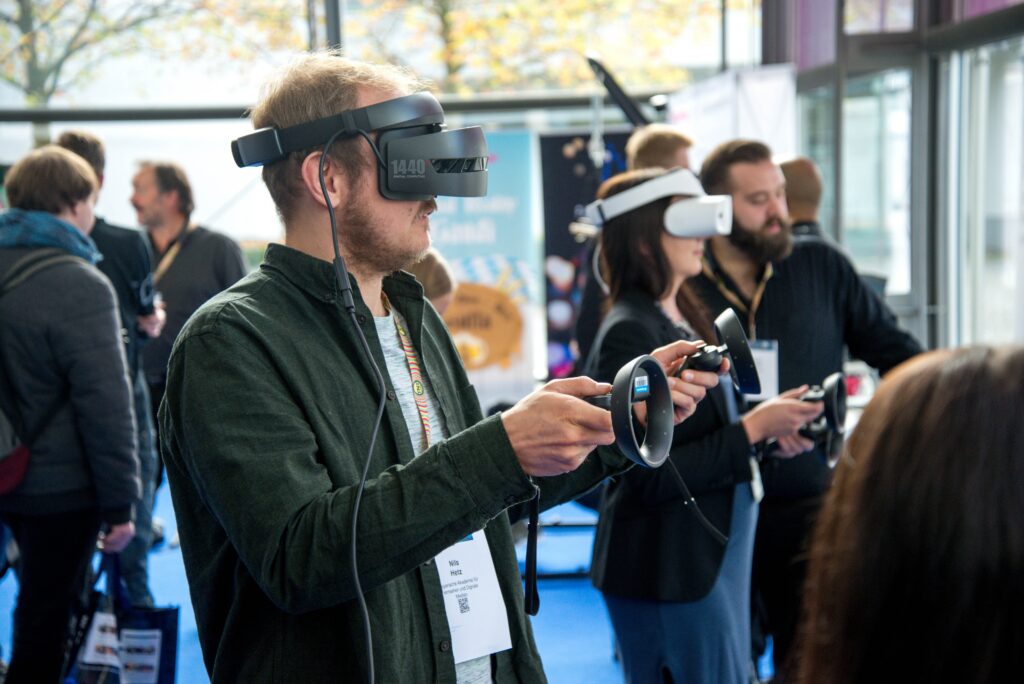A didactical framework for virtual reality in formal education

Despite the various potentials and risks of VR that have already been reported elsewhere, its expansion into formal education is still slow. The peculiarity of formal education, such as in vocational education or higher education, is that institutions often face challenges that can either promote or prevent educational innovations. Therefore, its barriers and supporting structures must be analysed thoroughly. Thus, in this podcast, I will develop an answer to the question of how can Virtual Reality be sustainably implemented into formal education. In doing this, I will present a specific didactical framework, recently developed in a project called Hotel Academy.
1. The Hotel Academy Project
The research and development project ‘Hotel Academy’ aims at designing a role-play scenario for students and teachers at universities specialized in the training and education of tourism and hotel management. More specifically, a learning environment based on VR technology (VRLE) provides a unique opportunity to handle a multitude of situations compared to real-life experiences in these fields. The aim is to develop the professional, methodological and social components that learners require for their (future) professional activities. All scenarios work online and include participants from three different universities in Cyprus, France, and Germany. The access is provided via head-mounted displays (HMD) of the newest generation, providing the full immersive effect of VR. Access to the environment is also possible via a computer. Each user can create his own personalized avatar that guarantees the best possible way of interaction and communication in a VR environment.
2. The didactical framework
A respective framework for the sustainable implementation of learning and teaching innovations was proposed by Euler and Seufert (2005), which provides the conceptual and theoretical basis for the documentation and validation of the didactical framework in the Hotel Academy project. The didactical framework describes different dimensions for the implementation of innovative technologies and, therefore, primarily supports the development and definition of innovation strategies in educational institutions.
Following the main idea of the Euler-and-Seufert framework (2005), so-called “education managers” must balance out risks and potentials of educational innovations in five main dimensions: Didactics, Organization, Technology, Economy, and Culture.
- The dimension Didactics focuses on the pedagogic benefits of educational innovations, the achievement of learning objectives, and the impact on curriculum design.
- The dimension Organization emphasizes the structural and procedural integration of innovative technologies into educational institutions.
- From a Technology perspective, aspects of IT infrastructure, IT policies, or IT governance must be considered when implementing VR in formal processes of educational institutions.
- To successfully integrate educational innovations into an institution in terms of Economy, costs and benefits must be balanced and existing business models be further developed.
- The dimension Culture describes behaviour, norms, and forms of cooperation and communication of the stakeholders involved in the process of teaching and learning. Sustainable implementation of educational innovations requires cultural adaptations and must, thus, be accompanied by change management activities.
In addition, the following three parameters must also be considered for the validation of the framework’s sustainability and, respectively, for the development of institution-specific VR strategies.
- The Education System defines the set of rules for structures and processes in the teaching and learning setting in which VR will be used. For example, scenarios in higher education institutions are characterized by more design freedom than school scenarios.
- The Institution contains the equipment, existing strategies, or cultural values as well as the existing support services. A well-developed IT infrastructure or experience in dealing with digital educational innovations, for example, facilitate the implementation of VR.
- Individuals are the target groups and stakeholders involved in the development of the VR environment. Therefore, we must focus on what experiences do users make, and how can their expectations be met?
3. Summary
The didactical framework—as introduced in today’s podcast—describes different dimensions for the implementation of innovations and, therefore, primarily supports the development and definition of innovation strategies in educational institutions. These dimensions include didactical, organizational, economical, technological and socio-cultural aspects that need to prepare before the implementation of VR strategies. It also takes into consideration the educational system, institutional requirements and individual peculiarities. If you want to learn more about this framework, please check out the text reference in the show notes or send me a message.
References:
Eulert, D., & Seufert, S. (2005). Change Management in der Hochschullehre: Die nachhaltige Implementierung von e-Learning-Innovationen. Zeitschrift für Hochschulentwicklung, 3, 3-15. https://zfhe.at/index.php/zfhe/article/view/187
Fischer, H., Arnold, M., Philippe, S., Dyrna, J., & Jung, S. (2021). VR-based Learning and Teaching. A Framework for Implementation of Virtual Reality in Formal Education. 15th International Technology, Education and Development Conference, Valencia, Spain, 8-10 March 2021. https://doi.org/10.21125/inted.2021.0694
Hotel Academy Project: https://erasmus-hotelacademy.com/

